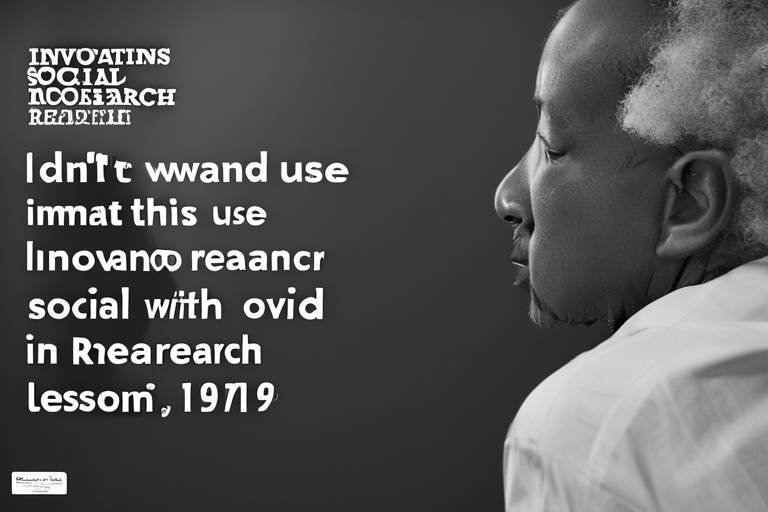Innovative Approaches to Focus Group Research
In the ever-evolving landscape of qualitative research, focus groups have emerged as a vital tool for gathering insights and understanding consumer behavior. However, traditional methods are often seen as outdated and lacking the engagement necessary to elicit genuine feedback. That's where innovative approaches come into play, transforming focus group research into a dynamic and interactive experience. By embracing modern methodologies, researchers can enhance data collection, foster participant engagement, and ultimately derive more insightful outcomes.
One of the most significant shifts in focus group research is the integration of technology. With tools like video conferencing, online survey platforms, and real-time analytics software, researchers can now conduct focus groups that are not only efficient but also captivating for participants. Imagine sitting in the comfort of your home, engaging in a lively discussion with others from diverse backgrounds, all while your thoughts are being captured and analyzed in real-time. This technological advancement not only streamlines the process but also opens the door to a broader range of participants, enriching the data collected.
Moreover, the selection of participants plays a crucial role in the effectiveness of focus group discussions. Researchers are moving away from homogeneous groups and are instead focusing on diverse participant selection strategies. By recruiting individuals from various backgrounds, demographics, and experiences, the conversations become richer and more insightful. This diversity can lead to unexpected revelations and a more comprehensive understanding of the subject matter. For instance, a focus group discussing a new product may include participants ranging from tech-savvy millennials to skeptical seniors, each contributing unique perspectives that can shape the final outcome.
As we navigate through these innovative approaches, it's essential to recognize the growing trend of online focus groups. The rise of digital communication has made it easier than ever to connect with participants across geographic boundaries. This section will explore the benefits and challenges of conducting focus groups in a virtual environment, emphasizing the importance of keeping participants engaged. The flexibility of online focus groups allows for scheduling convenience, but it also requires facilitators to employ creative strategies to maintain interest and encourage participation.
In the realm of virtual focus groups, effective facilitation becomes paramount. Facilitators are tasked with creating an environment that feels welcoming and stimulating, even through a screen. Best practices for virtual facilitation include using icebreakers, encouraging interaction through polls and questions, and actively managing the discussion flow. By establishing a rapport with participants, facilitators can foster an atmosphere where everyone feels comfortable sharing their thoughts.
To enhance engagement further, various tools can be utilized in online focus groups. Platforms that allow for interactive features—such as breakout rooms, live polls, and collaborative whiteboards—can significantly enrich the discussion experience. Participants can express their ideas visually and interactively, making the session not just informative but also enjoyable. This collaborative environment encourages participants to delve deeper into their thoughts and experiences, leading to more profound insights.
Another innovative approach lies in employing creative discussion techniques. Traditional focus group methods can sometimes lead to surface-level conversations. By incorporating techniques such as role-playing and storytelling, researchers can stimulate deeper conversations. For example, asking participants to role-play as their future selves using a new product can unveil feelings and thoughts that might not surface in a standard discussion format. This method not only promotes engagement but also allows participants to connect emotionally with the topic at hand.
As we explore these innovative methodologies, it's crucial to understand the importance of data analysis in focus group research. The insights gathered during discussions are only as valuable as the analysis that follows. Innovative analytical methods, including qualitative and quantitative approaches, can provide a holistic view of the data. Researchers can utilize AI tools to sift through transcripts, identifying key themes and patterns that emerge from the conversations. This integration of technology not only speeds up the analysis process but also enhances accuracy, ensuring that no valuable insight is overlooked.
In conclusion, the landscape of focus group research is undergoing a significant transformation. By embracing innovative approaches, researchers can enhance participant engagement, diversify participant selection, and employ creative techniques that lead to richer discussions. As we continue to navigate this evolving field, the potential for gaining meaningful insights will only grow, paving the way for more effective and impactful research outcomes.
- What are focus groups? Focus groups are qualitative research methods that involve guided discussions among a selected group of participants to gather insights on specific topics or products.
- Why is technology important in focus group research? Technology enhances real-time data collection and analysis, making the process more efficient and engaging for participants.
- How can I ensure diverse participant selection? By actively seeking participants from various backgrounds and demographics, researchers can enrich focus group discussions.
- What are some best practices for online focus groups? Effective facilitation, use of interactive tools, and creating a welcoming environment are key to successful online focus groups.
- How can creative techniques improve focus group discussions? Techniques like role-playing and storytelling can stimulate deeper conversations and encourage participants to share more openly.

Utilizing Technology in Focus Groups
In today's fast-paced world, the integration of technology into focus group research has transformed the way data is collected and analyzed. Gone are the days when researchers relied solely on traditional methods, such as pen and paper, to gather insights. Now, with the advent of various digital tools and platforms, focus groups can be conducted more efficiently, providing a richer and more engaging experience for participants. Imagine being able to capture real-time feedback while participants share their thoughts, all through the magic of technology!
One of the most significant advancements in focus group research is the use of online platforms. These platforms allow researchers to reach a broader audience without geographical limitations. Participants can join from the comfort of their homes, eliminating travel barriers and making it easier for diverse voices to be heard. The convenience of online focus groups also encourages higher participation rates, ensuring that a wide range of perspectives is represented.
Moreover, technology facilitates real-time data collection, enabling researchers to analyze responses as they come in. Tools such as live polling and interactive surveys can be integrated into focus group sessions, allowing participants to express their opinions instantly. This immediate feedback loop not only keeps participants engaged but also provides researchers with valuable insights that can be acted upon swiftly. For instance, using tools like Mentimeter or Slido can enhance the discussion by allowing participants to vote on topics or answer questions anonymously, fostering an open and honest environment.
Another innovative approach involves utilizing video conferencing tools such as Zoom or Microsoft Teams. These platforms not only enable face-to-face interactions but also allow researchers to record sessions for further analysis. This capability is particularly beneficial when reviewing nuanced discussions or capturing non-verbal cues that can be essential for understanding participant sentiments. Additionally, researchers can leverage features like breakout rooms to facilitate smaller group discussions, which can lead to more in-depth conversations.
To illustrate the impact of technology in focus groups, consider the following table that outlines the key benefits:
| Technology Tool | Benefits |
|---|---|
| Online Platforms | Broader reach, increased participation, convenience |
| Real-Time Polling | Immediate feedback, enhanced engagement, data accuracy |
| Video Conferencing | Face-to-face interaction, session recording, breakout discussions |
However, while technology brings numerous advantages, it also poses certain challenges. For instance, technical issues such as poor internet connectivity can disrupt sessions, leading to frustration among participants. Furthermore, not all participants may be comfortable using digital tools, which could limit their engagement. Therefore, it is crucial for researchers to provide clear instructions and support to ensure that everyone can participate fully.
In conclusion, the utilization of technology in focus groups has revolutionized qualitative research. By embracing these modern methodologies, researchers can enhance data collection and participant engagement, ultimately leading to more insightful outcomes. As we continue to navigate this digital age, the potential for technology to further improve focus group research is limitless. So, why not dive into the world of tech-savvy focus groups and unlock new dimensions of understanding?

Diverse Participant Selection Strategies
When it comes to focus group research, the importance of diversity in participant selection cannot be overstated. A diverse group brings a wealth of perspectives, experiences, and insights that can significantly enhance the quality of the discussions. But how do we ensure that our participant pool is truly representative? One innovative approach is to utilize a combination of traditional and modern recruitment strategies. For instance, while social media platforms like Facebook and LinkedIn can be effective in reaching specific demographics, local community organizations can help tap into underrepresented groups that might otherwise be overlooked.
Moreover, employing a stratified sampling method can be incredibly beneficial. This technique involves dividing your potential participants into subgroups based on characteristics such as age, gender, ethnicity, or socioeconomic status. By ensuring that each subgroup is represented in your focus group, you can obtain a more comprehensive understanding of the topic at hand. For example, if you're researching consumer behavior for a new product, including participants from various income levels can provide insights into how purchasing decisions differ across economic backgrounds.
Another strategy is to leverage incentives to attract a diverse range of participants. Offering compensation for their time or providing gifts can motivate individuals from different backgrounds to participate. However, it's essential to ensure that the incentives are appropriate and appealing to the target demographic. This approach not only increases participation rates but also helps in building a more varied participant base.
It's also important to consider the timing and location of focus group sessions. Hosting discussions at different times of the day and in various locations can make it easier for people with different schedules and responsibilities to attend. For example, offering sessions during weekends or evenings can attract working professionals who might otherwise be unable to participate. Similarly, holding sessions in community centers or local cafes can create a more welcoming environment for participants from diverse backgrounds.
Finally, utilizing technology can also play a crucial role in broadening your participant pool. Online focus groups, for instance, allow individuals from different geographical locations to join the conversation without the constraints of travel. This not only increases accessibility but also enhances diversity, as you can include participants from various regions and backgrounds. However, it’s essential to ensure that all participants have the necessary skills and access to technology to engage effectively in virtual discussions.
In conclusion, adopting innovative participant selection strategies is key to enriching focus group research. By utilizing a mix of traditional and modern methods, offering incentives, and being mindful of timing and location, researchers can create a diverse and engaging participant pool that leads to more insightful outcomes.
- Why is diversity important in focus group research?
Diversity ensures a range of perspectives, which enriches the discussion and leads to more comprehensive insights. - What are some effective recruitment strategies for diverse participants?
Utilize social media, community organizations, stratified sampling, and incentives to attract a varied participant base. - How can technology enhance participant diversity?
Online focus groups allow individuals from different locations to participate, increasing accessibility and representation. - What role do incentives play in participant recruitment?
Incentives can motivate individuals from various backgrounds to join focus groups, enhancing diversity.

Incorporating Online Focus Groups
In today's fast-paced digital world, incorporating online focus groups has become not just a trend, but a necessity for researchers aiming to gather valuable insights. The shift from traditional in-person gatherings to virtual platforms has opened up a realm of possibilities, allowing for greater flexibility and accessibility. Imagine being able to connect with participants from across the globe, all from the comfort of their own homes! This transformation is not just about convenience; it significantly enhances the richness of the data collected.
One of the most significant benefits of online focus groups is the ability to recruit a more diverse range of participants. With geographical barriers removed, researchers can tap into various demographics, ensuring that the discussions are not only comprehensive but also representative of different perspectives. However, it's essential to recognize that while online focus groups offer incredible advantages, they also come with their own set of challenges. For instance, maintaining participant engagement in a virtual setting can be tricky. Without the physical presence of a facilitator, participants might feel less inclined to share their thoughts openly.
To combat this, researchers can employ a variety of engagement techniques. Utilizing interactive tools such as polls, breakout rooms, and collaborative whiteboards can create a more dynamic environment. These tools not only encourage participation but also foster a sense of community among participants. For example, using a platform like Zoom allows facilitators to create breakout rooms for smaller discussions, which can lead to more intimate and honest conversations. This approach can be particularly effective in generating rich qualitative data.
Moreover, the integration of multimedia elements can enhance the experience even further. By incorporating videos, images, or even music into the discussion, facilitators can stimulate participants' creativity and prompt deeper reflections. This method can be particularly beneficial when discussing complex topics, as it allows participants to visualize and contextualize their thoughts. The key is to strike a balance between structure and spontaneity, ensuring that the conversation flows naturally while still adhering to the research objectives.
In conclusion, incorporating online focus groups into research methodologies is not just about adapting to the digital age; it's about leveraging technology to enhance the depth and breadth of qualitative insights. By embracing this innovative approach, researchers can uncover valuable perspectives that might have otherwise gone unnoticed. As we move forward, the ability to navigate both the opportunities and challenges presented by online focus groups will be crucial for anyone looking to conduct effective qualitative research.

Best Practices for Virtual Facilitation
Facilitating a virtual focus group can feel like navigating uncharted waters, especially if you're used to the traditional in-person setting. However, with the right strategies, you can create a vibrant and engaging environment that encourages participants to share their thoughts openly. First and foremost, establishing a clear agenda is essential. This not only sets expectations but also keeps the discussion focused and on track. Participants should know what to expect and feel prepared to contribute meaningfully.
Another critical aspect is the importance of building rapport among participants. In a virtual setting, this can be a bit trickier than in person. Start with some light icebreakers to help everyone feel comfortable. Perhaps you could ask participants to share something interesting about themselves or their favorite hobbies. This creates a sense of community and encourages more open dialogue. Remember, the goal is to make everyone feel valued and heard, as this will lead to richer discussions.
Additionally, utilizing visual aids can significantly enhance engagement. Think about incorporating slides, videos, or even interactive polls to keep the energy high. For instance, using a tool like Mentimeter can allow participants to vote on topics in real-time, making them feel more involved in the conversation. It’s like giving them a voice in steering the discussion, which can lead to more dynamic interactions.
Don’t forget about the technical aspects! Ensure that all participants have a stable internet connection and are familiar with the tools being used. A quick tech check before the session can save a lot of headaches later. If someone is struggling with technology during the discussion, it can disrupt the flow and disengage others. Consider creating a technical support document that participants can refer to if they encounter issues.
Lastly, always be prepared to adapt your facilitation style based on the group's dynamics. If you notice that certain participants are dominating the conversation, gently encourage quieter members to share their thoughts. This balance is crucial for gathering a wide range of insights. Remember, your role as a facilitator is to guide the conversation while ensuring everyone has a chance to contribute.
In summary, effective virtual facilitation is about creating an engaging environment where participants feel comfortable sharing their insights. By establishing a clear agenda, building rapport, utilizing visual aids, ensuring technical readiness, and adapting your style as needed, you can lead fruitful discussions that yield valuable qualitative data.
- What is the ideal number of participants for a virtual focus group? Generally, 6-10 participants is ideal, as it allows for diverse opinions while still being manageable for discussion.
- How long should a virtual focus group session last? Aim for 60-90 minutes. This duration is long enough to cover key topics without losing participants' attention.
- What tools are best for conducting virtual focus groups? Popular tools include Zoom, Microsoft Teams, and Google Meet, along with engagement tools like Mentimeter or Slido for interactive elements.
- How can I ensure all voices are heard during the discussion? Use techniques like round-robin sharing or direct questions to quieter participants to encourage their input.

Tools for Online Engagement
In today's digital age, engaging participants during online focus groups is more crucial than ever. With the right tools, you can transform a mundane virtual meeting into an interactive and stimulating experience. Imagine stepping into a vibrant online space where every voice matters, and ideas flow freely. This is the power of effective online engagement tools. By utilizing platforms that encourage participation, you can create an environment where participants feel valued and motivated to share their insights.
One of the standout tools for online engagement is video conferencing software. Platforms like Zoom, Microsoft Teams, and Google Meet not only allow for face-to-face interaction but also offer features like breakout rooms. These breakout rooms can facilitate smaller group discussions, enabling participants to dive deeper into specific topics. It’s like having a cozy corner in a coffee shop where intimate conversations can flourish, away from the larger crowd.
Additionally, integrating interactive polling tools such as Mentimeter or Slido can significantly enhance participant involvement. These tools allow you to conduct live polls, quizzes, and Q&A sessions, providing immediate feedback and insights. Picture this: during a discussion, you pose a thought-provoking question, and within seconds, participants can express their opinions through an anonymous poll. This not only sparks lively debate but also ensures that quieter voices are heard, leading to a richer discussion.
Moreover, utilizing collaborative whiteboards like Miro or MURAL can foster creativity and collaboration. These platforms allow participants to visually express their ideas, brainstorm, and organize thoughts in real-time. It’s akin to gathering around a large table with sticky notes and markers, where everyone can contribute to the big picture. This visual engagement can be particularly beneficial for complex topics that require collective input and creativity.
Lastly, don't underestimate the power of chat features. They provide a platform for participants to share their thoughts without interrupting the flow of conversation. By encouraging the use of chat, you create an avenue for those who may be hesitant to speak up verbally. This can lead to a more inclusive environment where everyone has the opportunity to contribute. Just think of it as passing notes in class—sometimes, the best ideas come from those quiet moments.
In summary, the right tools can make all the difference in online focus groups. By leveraging video conferencing software, interactive polling, collaborative whiteboards, and chat features, facilitators can create a dynamic and engaging environment that encourages participation and enriches discussions. After all, when participants feel engaged, the insights they provide are often more profound and valuable.
- What are the best tools for online engagement in focus groups? Popular tools include Zoom for video conferencing, Mentimeter for polling, and Miro for collaborative brainstorming.
- How can I ensure all participants are engaged during online focus groups? Use interactive tools, encourage chat participation, and create smaller breakout sessions to foster discussion.
- Can online focus groups be as effective as in-person ones? Yes, with the right tools and strategies, online focus groups can provide valuable insights and foster rich discussions.

Creative Discussion Techniques
When it comes to focus group research, traditional methods can sometimes feel a bit stale, right? That's where come into play. These innovative methods not only breathe life into conversations but also encourage participants to dive deeper into their thoughts and feelings. Imagine sitting in a circle, sharing stories, and engaging in role-playing games that spark genuine dialogue. Sounds fun, doesn’t it? Well, that’s the magic of creativity in focus groups!
One of the most effective techniques is storytelling. By inviting participants to share personal anecdotes related to the topic at hand, you create a warm and inviting atmosphere. This approach not only helps participants to feel more comfortable but also encourages them to express their thoughts in a more relatable manner. Think of it as building a bridge between their experiences and the research objectives. When people hear stories, they often resonate with them, leading to richer discussions and insights.
Another engaging technique is role-playing. This method allows participants to step into different shoes—whether it’s a customer, a competitor, or even a product itself. By acting out scenarios, participants can explore various perspectives, which often leads to unexpected insights. For example, if you're researching a new product, ask participants to pretend they are the product in a store. How would they feel? What would they say? This imaginative approach can uncover hidden emotions and thoughts that standard questioning might miss.
Additionally, incorporating visual aids can significantly enhance the discussion. Using images, videos, or even infographics can help participants visualize concepts and ideas, making it easier for them to articulate their thoughts. Picture this: you show a compelling image related to your research topic, and suddenly, a flood of ideas and feelings pour out from the group. Visuals can be a powerful catalyst for conversation, sparking creativity and engagement.
Furthermore, consider utilizing interactive exercises. For instance, you could have participants work in small groups to brainstorm solutions to a problem or create a mind map of their thoughts. This not only fosters collaboration but also encourages quieter participants to contribute. When people work together, they often build off each other's ideas, leading to a richer discussion overall. Plus, it keeps the energy up and the atmosphere lively!
The key to these creative techniques is to keep the environment relaxed and open. Encourage participants to share freely without fear of judgment. After all, the goal is to uncover insights that can lead to meaningful outcomes. By incorporating these engaging methods, you can transform your focus group discussions into vibrant conversations that yield valuable data.
- What are creative discussion techniques? Creative discussion techniques are innovative methods used in focus groups to encourage deeper conversations and participant engagement, such as storytelling, role-playing, and visual aids.
- How do these techniques improve focus group outcomes? They create a more relaxed atmosphere, stimulate genuine dialogue, and often lead to unexpected insights that traditional methods may overlook.
- Can these techniques be applied to online focus groups? Absolutely! Many of these techniques, such as storytelling and visual aids, can be easily adapted for virtual environments, enhancing engagement even in online settings.

Analyzing Focus Group Data
When it comes to , the process is far from straightforward. It requires a mix of creativity, analytical skills, and a deep understanding of the subject matter. Focus groups generate a wealth of qualitative data, but without the right analytical approach, those insights can remain buried beneath layers of conversation. So, how do we sift through all that information to extract meaningful insights? Let's dive into the innovative analytical methods that can transform your focus group discussions into actionable data.
One of the first steps in analyzing focus group data is to categorize the information. This can be done through a process called thematic analysis, where you identify recurring themes or patterns in the discussions. By organizing the data into themes, you can better understand the participants' perspectives and experiences. For instance, if your focus group was discussing a new product, themes might emerge around usability, design, and customer service. These categories help to streamline the analysis and make it easier to draw conclusions.
In addition to thematic analysis, researchers often employ a combination of qualitative and quantitative analysis. This dual approach allows for a more comprehensive view of the data. While qualitative analysis focuses on understanding the nuances of participants' opinions and feelings, quantitative analysis can provide statistical insights that highlight trends and correlations. For example, if a significant number of participants express dissatisfaction with a product feature, it indicates a clear area for improvement. This blend of methodologies enriches the overall analysis and helps to paint a fuller picture of the discussion.
Another exciting avenue in data analysis is the use of artificial intelligence (AI). With the advancements in technology, AI tools can now efficiently analyze focus group transcripts, identifying key themes and patterns that might be overlooked by human analysts. These tools can process large volumes of text in a fraction of the time, allowing researchers to focus on interpretation rather than data collection. Imagine having a virtual assistant that highlights the most relevant insights from hours of discussion—it's like having a superpower for data analysis!
To illustrate the effectiveness of AI in focus group analysis, consider the following table, which compares traditional analysis methods with AI-enhanced approaches:
| Aspect | Traditional Analysis | AI-Enhanced Analysis |
|---|---|---|
| Time Required | Hours to Days | Minutes to Hours |
| Data Volume | Limited by Human Capacity | Can Analyze Large Datasets |
| Pattern Recognition | Subjective | Objective and Data-Driven |
| Insights Generated | Potentially Missed | Comprehensive |
In conclusion, analyzing focus group data is a multifaceted process that can greatly benefit from innovative methodologies. Whether you're employing thematic analysis, combining qualitative and quantitative approaches, or leveraging AI tools, the goal remains the same: to uncover insights that can drive decision-making and strategy. Remember, the key to successful analysis lies not just in the methods you choose, but in how you interpret and apply those insights to your research objectives.
- What is the main purpose of focus group analysis? The main purpose is to extract meaningful insights from discussions to inform decision-making and strategy.
- How can I ensure diverse data in my focus group? By selecting participants from varied backgrounds and using targeted recruitment strategies.
- What role does AI play in focus group analysis? AI can assist in efficiently analyzing large volumes of data, identifying patterns, and generating insights quickly.

Qualitative vs. Quantitative Analysis
When diving into the world of focus group research, one of the most crucial distinctions to grasp is the difference between qualitative and quantitative analysis. These two approaches serve unique purposes and can be incredibly powerful when used together. Think of qualitative analysis as the rich, colorful tapestry of human experience, while quantitative analysis is the precise, structured framework that helps us measure and understand those experiences numerically. They complement each other beautifully, providing a more holistic view of the data.
Qualitative analysis focuses on understanding the why and how behind participants' thoughts and feelings. It dives deep into the nuances of human behavior, exploring emotions, motivations, and perceptions. This method often involves open-ended questions, allowing participants to express themselves freely. For example, during a focus group discussion about a new product, qualitative insights might reveal why a specific feature resonates with users or how it fits into their daily lives. This depth of understanding can be invaluable for product development and marketing strategies.
On the other hand, quantitative analysis is all about the numbers. It seeks to quantify the data collected, providing measurable insights that can be statistically analyzed. This approach often utilizes closed-ended questions, where participants choose from predefined options. For instance, if you ask participants to rate their satisfaction with a product on a scale of 1 to 10, you can easily calculate the average score, which provides a clear picture of overall sentiment. This numeric data is essential for identifying trends, making comparisons, and supporting business decisions with hard evidence.
To illustrate the differences further, consider the following table:
| Aspect | Qualitative Analysis | Quantitative Analysis |
|---|---|---|
| Focus | Understanding meanings and experiences | Measuring and quantifying data |
| Data Collection Methods | Interviews, open-ended surveys, focus groups | Closed-ended surveys, experiments, statistical data |
| Data Type | Textual, descriptive data | Numerical data |
| Outcome | Rich insights and themes | Statistical trends and patterns |
Combining both qualitative and quantitative methods can lead to a more comprehensive understanding of the research topic. For example, after conducting a focus group and gathering qualitative data, researchers can follow up with a quantitative survey to test the insights gained. This dual approach not only validates findings but also enhances the credibility of the research.
In conclusion, while qualitative and quantitative analyses serve different purposes, their integration can provide a powerful toolkit for researchers. By understanding the strengths of each method, you can create a more nuanced and effective research strategy that captures the full spectrum of human experience.
- What is the main difference between qualitative and quantitative analysis?
Qualitative analysis focuses on understanding the meaning behind experiences, while quantitative analysis seeks to measure and quantify data. - Can qualitative and quantitative methods be used together?
Absolutely! Combining both methods enhances research validity and provides a more comprehensive understanding of the topic. - What types of questions are used in qualitative research?
Qualitative research often uses open-ended questions that allow participants to express their thoughts and feelings freely. - What are some examples of quantitative research methods?
Common quantitative methods include surveys with closed-ended questions, experiments, and statistical analysis of existing data.

Leveraging AI for Data Interpretation
In the fast-paced world of qualitative research, leveraging artificial intelligence (AI) for data interpretation has become a game-changer. Imagine sifting through hours of focus group discussions, trying to identify key themes and insights. It can feel like searching for a needle in a haystack, right? But with AI, that daunting task transforms into a more manageable and efficient process. AI tools can analyze transcripts at lightning speed, extracting valuable information that may take a human analyst days or even weeks to uncover.
AI algorithms are designed to recognize patterns and trends in large volumes of text, making them incredibly effective in identifying recurring themes and sentiments. By employing natural language processing (NLP), these tools can understand the context and nuances of conversations, which is crucial in qualitative research. For instance, if participants express frustration about a product, AI can not only flag those comments but also categorize them based on the intensity of the sentiment expressed. This level of analysis provides researchers with a richer understanding of participant perspectives.
Moreover, AI can help in reducing human bias. Traditional analysis methods may inadvertently reflect the analyst's personal biases or interpretations. However, AI operates on data-driven algorithms, ensuring that the insights derived are based solely on participant feedback. This leads to more objective and reliable results. Additionally, AI can facilitate the creation of visual data representations, such as word clouds or sentiment graphs, which can make it easier for researchers to present their findings in a compelling manner.
Here's a quick overview of how AI enhances data interpretation:
| AI Benefits | Description |
|---|---|
| Speed | Processes large volumes of data in a fraction of the time it takes a human. |
| Pattern Recognition | Identifies themes and sentiments that might be missed in manual analysis. |
| Bias Reduction | Ensures objectivity by relying on data rather than personal interpretation. |
| Visual Representation | Creates engaging visuals to present findings effectively. |
However, while AI tools are incredibly powerful, they are not a complete substitute for human insight. The best approach is a hybrid model where AI assists researchers in preliminary analysis, but human analysts still play a crucial role in interpreting the data and providing context. By combining the speed and efficiency of AI with the nuanced understanding of human researchers, organizations can achieve a comprehensive analysis that drives actionable insights.
As we continue to embrace technology in research, the integration of AI in data interpretation will undoubtedly become more sophisticated. Researchers who adapt to these innovations will not only enhance their analytical capabilities but also stay ahead in the competitive landscape of qualitative research.
- What is AI data interpretation? AI data interpretation refers to the use of artificial intelligence tools to analyze and derive insights from qualitative data, such as focus group discussions.
- How does AI reduce bias in data analysis? AI reduces bias by relying on data-driven algorithms, ensuring that insights are based on participant feedback rather than personal interpretations.
- Can AI completely replace human analysts? No, AI should be used as a tool to assist human analysts; the combination of both leads to the best results.
- What are some popular AI tools for data analysis? Some popular AI tools include NVivo, MAXQDA, and Dedoose, which offer various functionalities for qualitative data analysis.
Frequently Asked Questions
- What are focus groups?
Focus groups are guided discussions with a selected group of participants aimed at gathering insights on specific topics or products. They are a valuable qualitative research method that helps researchers understand attitudes, perceptions, and motivations.
- How can technology enhance focus group research?
Technology can streamline the focus group process by enabling real-time data collection and analysis. Tools like video conferencing, online surveys, and interactive platforms can make discussions more engaging and accessible, especially for remote participants.
- Why is participant diversity important in focus groups?
Diverse participant selection enriches the discussion by bringing in varied perspectives and experiences. This diversity leads to more comprehensive insights, making the findings more relevant and applicable to a broader audience.
- What are the benefits of online focus groups?
Online focus groups offer flexibility, convenience, and the ability to reach participants from different geographic locations. They can also reduce costs associated with travel and venue hire, making them a popular choice for researchers.
- What are some best practices for facilitating virtual focus groups?
Effective virtual facilitation includes preparing an engaging agenda, using interactive tools to encourage participation, and creating a welcoming environment. Facilitators should also be skilled in managing discussions to ensure all voices are heard.
- How can creative discussion techniques improve focus group outcomes?
Creative techniques like role-playing and storytelling can stimulate deeper conversations and encourage participants to express their thoughts more freely. These methods can lead to richer data and more insightful findings.
- What is the difference between qualitative and quantitative analysis in focus groups?
Qualitative analysis focuses on understanding the underlying motivations and feelings of participants, while quantitative analysis involves statistical methods to quantify data. Both approaches complement each other, providing a well-rounded view of the research topic.
- How can AI be used in analyzing focus group data?
AI tools can assist in analyzing focus group transcripts by identifying key themes, patterns, and sentiments. This technology can significantly speed up the data interpretation process, allowing researchers to focus on deriving insights rather than getting bogged down in manual analysis.



















